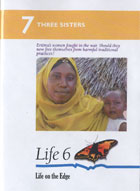
Life 6: Three Sisters 2008
Distributed by Bullfrog Films, PO Box 149, Oley, PA 19547; 800-543-FROG (3764)
Produced by Television Trust for the Environment
Director n/a
DVD, color, 26 min.
Sr. High - Adult
Women's Studies, African Studies, Multicultural Studies
Date Entered: 04/27/2009
Reviewed by Miriam Conteh-Morgan, The Ohio State University Libraries, Columbus, OHIt is not often that African women are depicted as soldiers on the frontline fighting side by side with their men folk on the battlefield, yet this ‘progressive’ idea is a historical fact about Eritrea. In the thirty years of fighting a war of independence from Ethiopia—from 1961 to 1991—women played prominent roles in helping to liberate their country. But even as they had bled and died for national freedom, they were relegated to the back of the social line in the years following independence, and their quest for personal freedoms has remained an ongoing struggle.
Three Sisters highlights the lives of rural women, Leyla, Amina and Howa as they question traditions and practices, and try to push the limits of their patriarchal society. They represent a sisterhood of women who are torn between thinking of other ways of living their traditional lives without losing their rootedness in the culture. Their anguish is externalized in their discussion about whether to circumcise a second daughter or not, give birth to a seventh child at home again or in a nearby clinic, or the need to break out of the poverty trap by owning a farm. These choices made available to them -- by the national law against circumcision (but which is not enforced in their rural setting); by the medically safe environment at the health clinic but where there is also the probability that cultural practices will not be followed, and by enabling government and civil society officials whose assistance could mean a change in gender roles – which while seen as liberating, also threaten to destabilize the women’s world.
The film raises complex issues but leaves them unresolved at the end. These women’s dilemmas may be specific to their cultural situation, but they have been played out in various ways around the world as women struggle for social and economic equality. The film treats these issues with objectivity and sensitivity, which is a refreshing departure from others that filter such questions through the “us-and-the-other” lenses. In the classroom, Three Sisters will provide rich material for multi-layered discussions about gender, cultural practices, and development.